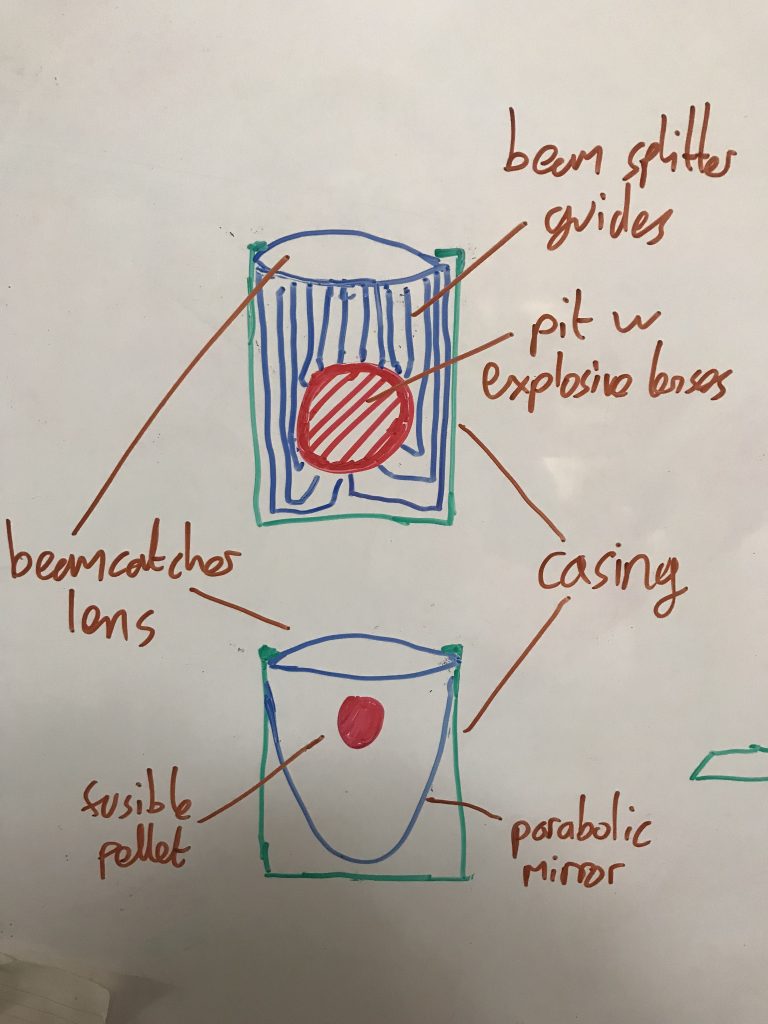Hello, and welcome once again to Truly Awful Whiteboard Pictures season, as I present to you the basic workings of a nuclear-pulse Orion drive, Empire-style. Or at least Empire-of-the-Spaceflight-Initiative-Era style. Mostly so that I can refer to it later and y’all’ll know what I’m talking about.
Behold ye first (and note that I’m not really getting into explaining the Orion drive itself at this point: for that see here, which should give you an idea of what I’m riffing on) an exceptionally crude and simplified illustration of the mechanics of the drive itself:

The way this works as part of each firing cycle is approximately this:
- A pulse unit, taken from the magazines, is fed by the loader into the breech/spinner and magnetically suspended there. The “spinner” spins it up for the purpose of spin-stabilization, as later in the process, it will be vitally important that the coaxial firing laser be able to lay a beam on the lens at one end of the soda-can-sized pulse unit.
- The irises (both the primary one built into the pusher plate, and the secondary one at the end of the coilgun, snap open to let the pulse unit pass.
- The coilgun throws the pulse unit out and down towards firing position.
- As the pulse unit reaches firing position, the firing laser delivers an ignition pulse to it (right down the now-empty bore of the coilgun). The pulse unit does its prompt critical thing.
- Immediately afterwards, before the plasma from the pulse unit detonation can reach the pusher plate, the primary and secondary irises snap closed to protect the firing mechanism from the detonation.
- And repeat for the next cycle.
As for the pulse units themselves, they look like this. Very roughly, as I’m eliminating all the complexity that goes into making them Happy Fun Shaped Charges as well as streamlined, spin-stabilized projectiles. Conceptual only:

The upper one is the old-style fission-based unit. Basically, it’s a laser-triggered fission bomb. The firing laser hits the beamcatcher lens, which splits the laser impulse into many beamlets proceeding along optical fibers, which are set up so that the laser impulselets reach the various explosive lenses surrounding the pit at the same moment. Implosion, prompt criticality, and fission pulse proceed to happen.
The lower one is the new hotness fusion-based unit. It’s a laser-triggered pure fusion bomb. In this case, the beamcatcher lens focuses the considerably more powerful laser impulse onto a parabolic mirror and needed secondary mirrors (not shown), for the purpose of delivering the laser impulse to all sides of a fusible pellet at the same time, even as the mirrors themselves are busy vaporizing. Fusible pellet hits inertially-confined criticality, and fusion pulse proceeds to happen.
The important thing to note here is that as much of the complexity as possible has been offloaded from the pulse units to the drive, inasmuch as you might want to knock a quick thousand pulse units out in the field with a relatively crude shipboard machine shop, which is not something you would expect to be able to build the drive.
